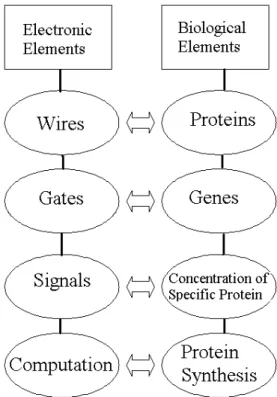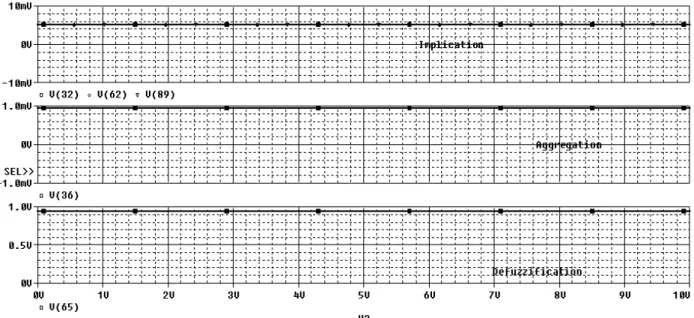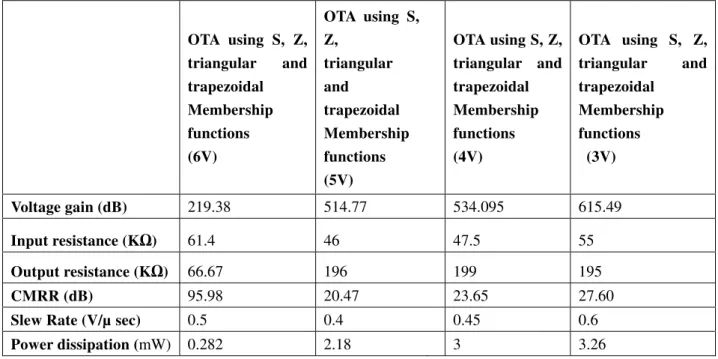Network Biology, 2015, 5(2): 62-70
IAEES www.iaees.org Article
Implementation of fuzzy system using different voltages of OTA for
JNK pathway leading to cell survival/ death
Shruti Jain1, D.S. Chauhan2 1
Department of Electronics and Communication Engineering, Jaypee University of Information Technology, Waknaghat, Solan, Himachal Pradesh 173234. India
2
GLA University, Mathura, Uttar Pradesh, 281406. India E-mail: jain.shruti15@gmail.com
Received 5 December 2014; Accepted 13 January 2015; Published online 1 June 2015
Abstract
In this paper a well defined method for the design of JNK pathway for epidermal growth factor/ insulin using fuzzy system using operational transconductance amplifier was discussed. Fuzzy system includes fuzzification of the input variables, application of the fuzzy operator (AND or OR) in the antecedent, implication from the antecedent to the consequent, aggregation of the consequents across the rules, and defuzzfication. Fuzzy system with various electrical parameters for different voltages of OTA with different membership function was found. Results with 3V were the best.
Keywords epidermal growth factor (EGF)/ insulin; Jun N-terminal kinases (JNK); operational transconductance amplifier; fuzzy system; electrical parameters.
1 Introduction
Cell signaling pathways interact with one another to form networks. Such networks are complex in their organization and exhibit emergent properties such as bistability and ultra sensitivity. Analysis of signaling networks requires a combination of experimental and theoretical approaches including the development and analysis of models (Kevin et al., 2005; Gaudet et al., 2005; Weiss, 2001).
Bioelectronics encompasses a range of topics at the interface of biology and electronics. One aspect of the application of electronics in biology, medicine, and security includes both detection and characterization of biological materials, such as on the cellular and sub cellular level. Another aspect of bioelectronics is using biological systems in electronic applications (e.g., processing novel electronic components from DNA, nerves, or cells). Bioelectronics also focuses on physically interfacing electronic devices with biological systems (e.g., brain-machine, cell-electrode, or protein-electrode). Applications in this area include assistive technologies for individuals with brain-related disease or injury, such as paralysis, artificial retinas, and new technologies for
Network Biology ISSN 22208879
URL: http://www.iaees.org/publications/journals/nb/onlineversion.asp RSS: http://www.iaees.org/publications/journals/nb/rss.xml
Email: networkbiology@iaees.org EditorinChief: WenJun Zhang
protein structure-function measurements. Fig. 1 shows the comparison of electronics and biological elements.
Fig. 1 Comparison of electronics and biological elements.
The decision between cell survival/ cell death is well regulated by three input signals : TNF, EGF and insulin. These factors in single or in combination activate various key players in the network pertaining to cell survival/ cell death. The epidermal growth factor (EGF) and EGF receptor (EGFR) were among the first growth factor ligand-receptor pairs discovered (Jain, 2012; Ullrich, 1990). Subsequently, EGFR was found to be a member of a receptor tyrosine kinase (RTK) family, the human epidermal growth factor receptor (HER) family (Arteaga, 2003; Jain et al., 2011). Each Insulin/Glucose Phospho-Antibody Array includes 85 highly specific and well-characterized phosphorylation antibodies in the Insulin/Glucose pathway. The epidermal growth factor receptor (EGFR) family plays an important role in cell lineage determination, the morphogenesis of many organs and in cell survival in the adult. Moreover, activating mutants and over-expression of these family members contribute to oncogenesis by inducing cells to proliferate and to resist cell death. Subsequent phosphorylation of the HER-kinase itself and/or other proteins, which then pass on to various signaling cascades (e.g., phosphoinositide 3-kinase (PI3K)/Akt mitogen-activated protein kinase (MAPK) pathways and, JAK/ STAT pathway), can lead to different cellular events such as growth, migration, and division. Insulin receptor substrate 1 (IRS-1) plays important biological function for both metabolic and mitogenic (growth promoting) pathways: mice deficent of IRS1 have only a mild diabetic phenotype, but a pronounced growth impairment, i.e. IRS-1 plays a key role in transmitting signals from the insulin and insulin-like growth factor-1 (IGF-1) receptors to intracellular pathways PI3K / Akt and Erk MAP kinase pathways.
Network Biology, 2015, 5(2): 62-70
IAEES www.iaees.org osmolarity glycerol where the p38 proteins are a subfamily. Each of these pathways led to the dual phosphorylation of MAP kinase family members responsible for activation of transcription factors.
This paper presents the implementation of JNK pathway using fuzzy system using operational transconductance amplifier (OTA) with different voltages. There are five parts of the fuzzy system (Jain, 2014a, b, c). Fuzzification of the input variables, application of the fuzzy operator (AND or OR) in the antecedent,
implication from the antecedent to the consequent, aggregation of the consequents across the rules, and defuzzfication.
Operational Transconductance Amplifier (OTA) is a voltage controlled current source (VCCS) (Jain, 2014a, b, c). The input stage will be a CMOS differential amplifier. Since the output resistance of the differential amplifier is reasonably high. If both higher output resistance and more gain are required, then the
second stage could be a cascade with a cascade load. The output is current; to convert current to voltage we can use current mirror circuit is used at the output side of VCCS circuit. Current mirror circuit increases the
gain of the circuit.
This paper presents the electrical parameters i.e. differential input resistance, output resistance, large signal voltage gain (20 log10 Vo/Vid in dB), common mode rejection ratio (CMRR) (20 log(Ad / Acm) in dB), slew rate (SR) (max (dVo / dt ) in V/µsec). For simulation and calculation of parameters I have used SPICE software (Rashid, 2009).
2Signaling Pathway of Egf/ Insulin
Epidermal growth factor (EGF) / Insulin is a growth factor that plays an important role in the regulation of cell
growth, proliferation, and differentiation. It also increases cancer risk. EGF acts by binding with high affinity to epidermal growth factor receptor (EGFR) on the cell surface and stimulating the intrinsic protein-tyrosine
kinase activity of the receptor (see the second diagram). The tyrosine kinase activity, in turn, initiates a signal transduction cascade that results in a variety of biochemical changes within the cell - a rise in intracellular calcium levels, increased glycolysis and protein synthesis, and increases in the expression of certain genes
including the gene for EGFR / IRS-1 that ultimately lead to DNA synthesis and cell proliferation (Jain, 2012; Jain, 2014a, b, c).
Upon ligand-binding receptors homo-dimerise or hetero-dimerise triggering tyrosine trans- phosphorylation of the receptor sub-units. These tyrosine phosphorylated sites allow proteins to bind through their Src homology 2 (SH2) domains leading to the activation of downstream signaling cascades including the
RAS/extracellular signal regulated kinase (ERK) pathway, the phosphatidylinositol 3 kinase (PI3K) pathway and the activator of transcription (JAK/ STAT) pathway. Differences in the C-terminal domains of the ErbB
receptors govern the exact second messenger cascades that are elicited conferring signaling specificity. The EGF signal is terminated primarily through endocytosis of the receptor-ligand complex. The contents of the endosomes are then either degraded or recycled to the cell surface. A number of signal transduction pathways
branch out from the receptor signaling complex as shown in Fig. 2.
The most widely studied MAP kinase cascade is the JNK/SAPK (c-Jun NH2-terminal kinase/stress
activated protein kinase). The c-Jun kinase (JNK) is activated when cells are exposed to ultraviolet (UV) radiation, heat shock, or inflammatory cytokines. However, the functionalconsequence of JNK activation in UV-irradiated cells has not beenestablished. The absenceof JNK caused a defect in the mitochondrial death
signaling pathway,including the failure to release cytochrome c (Jain, 2012).
3 Methodology
for JNK MAPK)
linguistic JNK (MA death. A designed Ass linguistic function. present a function Seco OR (max The I I I Bef
part is ru
pathway of E pathway use
c variables to APK) is abse Assign memb
d all members
ign different
c variable: ab . Let’s define as 3V. Similar
as 3V.Ihave ond step was
x) and inverte e rules are:
IF SOS is RA
IF SOS is RA IF SOS is RA
fore THEN an
ule compositi
EGF/Insulin. ed in EGF. Le
all input and ent, not lying
ership functi ship functions
Fig. 2 Illustrati
t membership
bsent as 0-4, these ranges rly,RAF as 1
e assumed ref rule compos er. I have desi
AF AND JNK
AL AND JNK AL AND JNK
nd after IF is
ion part and
The problem et’s assume i
d output. The g and present
ions (S, Z, tr s using OTA
ion of signal co
p functions t
not lying as s in volts so a V, RAL as 2V ference voltag sition i.e. IF-T igned all the o
K is not lying
K is present TH K is absent TH
s known as a
consequent p
m is to estimat inputs as SO
linguistic va t while, for s
riangular and (Jain, 2014a,
ommunication n
to all linguis
s 3-7 and pre as to impleme V and p38 as ge as 4V and THEN statem
operators usin
THEN state o
HEN state of HEN state of c
antecedent pa
part is implic
te cell surviva S and JNK a
ariables define state of cell a
d trapezoidal b, c).
network triggere
stic variables
esent as 6-10 ent electronic 3V, and cell
the OTA wor ment. There ar
ng OTA (Jain
of cell is no f
f cell is surviv cell is death.
art and after T
ation process
al or death fo and output as
ed for SOS ar are cell survi
l) to every li
ed by EGF/ Ins
. Then, we d
.Similarly, fo cally: absent a survival as 1
rks at 4V. re different o
n, 2014a, b, c)
function.
val.
THEN is con
s. Third step
or JNK (one o s state of cel
re RAF, RAL ival, no func
inguistic vari
sulin.
define the ra
or every inpu as 1V, not lyi
V, cell death
operators like
).
nsequent part
implication
of the path of ll. Define the
L and p38, for tion and cell
iable. I have
ange of each
ut and output ing as 2V and as 2V and no
AND (min),
t. Antecedent
Network Biology, 2015, 5(2): 62-70
IAEES www.iaees.org different types but in this paper I have used mamdani implication style. Electronically rules are used as
IF SOS is RAF (1V) AND JNK is not lying (2V) THEN state of cell is no function (3V).
IF SOS is RAL (2V) AND JNK is present (3V) THEN state of cell is survival (1V).
IF SOS is RAL (2V) AND JNK is absent (1V) THEN state of cell is death (2V).
Similarly we can make different rules. I have implemented only three rules electronically and, get their
output. Fourth step is to aggregate (add) the every output after implication process and then final step is to defuzzify it. In this paper I have used Maximum defuzzification techniques.
Fig. 3 shows the output after every step. V(32), V(62) and V(89) are the output after mamdani implication
process, V(36) is output after aggregating all the rules which we are getting after implication process. V(65) is the final output i.e defuzzified output.
Fig. 3 Final output of Fuzzy System using 6V.
Let’s vary the OTA voltages from 3V to 6V. Aspect ratio (W/L) is calculated for every voltage value
shown in Table 1.
Table 1 Different values of W/L for different OTA voltages.
OTA voltage 6V 5V 4V 3V
(W/L)1 = (W/L)2 41.42 18.4 27.6 20.7
(W/L)3 = (W/L)4 0.125 0.22 0.75 4
(W/L)5 = (W/L)6 0.247 0.16 0.232 0.291
(W/L)7 = (W/L)8 0.518 0.336 0.48 0.611
ID (µA) 50 50 75 100
Fig. 4, Fig. 5 and Fig. 6, shows the fuzzy system using different voltages of OTA i.e. 5V, 4V and 3V respectively. The output after every step i.e. V(32), V(62) and V(89) are the output after mamdani implication
process, V(36) is output after aggregating all the rules which we are getting after implication process. V(65) is the final output, i.e., defuzzified output.
Fig. 4 Final output of fuzzy system using 5V.
Network Biology, 2015, 5(2): 62-70
IAEES www.iaees.org
Fig. 6 Final output of fuzzy system using 3V.
Consider the different membership functions as input. Table 2 (includes only S and Z membership
function) and Table 3 (S, Z, triangular and trapezoidal membership function) show the comparison of electrical parameters of balanced OTA. Results using 3V and all membership functions are the best. In this I have
considered all (S, Z, triangular and trapezoidal membership function) membership functions for various linguistic variables instead of only one or two.
Table 2 Comparison of the electrical parameters of fuzzy system using signoidal (S) and anti-sigmoidal (Z) membership function only.
Balanced OTA using S and Z Membership
functions (6V)
Balanced OTA using S and Z Membership
functions (5V)
Balanced OTA using S and Z
Membership functions
(4V)
Balanced OTA using S and Z Membership
functions (3V)
Voltage gain (dB) 42.325 51.77 53.095 61.49
Input resistance (KΩ) 45 46 47.5 55
Output resistance (KΩ) 66.6 196 199 195
CMRR (dB) 18.02 20.47 23.65 27.60
Slew Rate (V/µ sec) 0.5 0.4 0.45 0.6
Power dissipation (mW) 0.217 2.18 3 3.26
Table 3 Comparison of the electrical parameters of fuzzy system using any S, Z, triangular and trapezoidal membership function.
OTA using S, Z, triangular and
trapezoidal Membership
functions (6V)
OTA using S, Z,
triangular
and
trapezoidal
Membership functions (5V)
OTA using S, Z, triangular and
trapezoidal Membership
functions (4V)
OTA using S, Z, triangular and
trapezoidal Membership
functions (3V)
Voltage gain (dB) 219.38 514.77 534.095 615.49
Input resistance (KΩ) 61.4 46 47.5 55
Output resistance (KΩ) 66.67 196 199 195
CMRR (dB) 95.98 20.47 23.65 27.60
Slew Rate (V/µ sec) 0.5 0.4 0.45 0.6
Power dissipation (mW) 0.282 2.18 3 3.26
The OTA is a current source, and the output impedance of the device is high, in contrast to the op-amp’s very low output impedance. To increase the speed of the system, CMRR should be high. In our calculations CMRR is very high.
4 Conclusion
The paper gives the designing of the JNK pathway of EGF/ insulin using fuzzy system using OTA. I have successfully designed and implemented all the steps of fuzzy system i.e. fuzzification, rule composition, implication, aggregation and defuzzification process for various rules. I have also calculated its various
parameters like slew rate, CMRR, power dissipation, gain, input resistance and output resistance using S and Z membership function as one and all membership functions as second with different voltages of OTA. The
results with 3V of OTA and different membership functions are the best.
Abbreviations
ASK1, Apoptosis signal-regulating kinase 1; CMRR, Common mode rejection ratio; EGF, epidermal growth
factor; EGFR, epidermal growth factor receptor; ERK, extracellular-regulated kinase; Grb2, growth factor receptor-bound 2; IGF, insulin-like growth factor; IκB, I Kappa B (nuclear factor of kappa light polypeptide gene enhancer in B-cells inhibitor); IKK, IκB kinase; IR, insulin receptor; IRS1, insulin receptor substrate 1;
JNK1, c-jun NH2 terminal kinase 1; MAP kinases, mitogen-activated protein kinases; MEK, mitogen-activated protein kinase and extracellular-regulated kinase kinase; MK2, mitogen-activated protein kinase-activated
protein kinase 2; NF-κB, nuclear factor-κB; OTA, Operational Transconductance amplifier; PLADD, pre-ligand assembly domain; PI3K, phosphatidylinositol 3-kinase; p38, P38 mitogen-activated protein kinases; SAPK/JNK , Stress-activated protein kinase/Jun-amino-terminal kinase; SH2, Src homolgy 2; SOS, Son of
Network Biology, 2015, 5(2): 62-70
IAEES www.iaees.org References
Allen PE, holberg DR. 2011. CMOS Analog Circuit Design. International Student Edition, Oxford, UK
Arteaga C. 2003. Targeting HER1/EGFR: a molecular approach to cancer therapy Seminars in Oncology, 30: 314
Gaudet S, Kevin JA, John AG, et al. 2005. A compendium of signals and responses trigerred by prodeath and
prosurvival cytokines. Manuscript M500158-MCP200.
Jain S, Bhooshan SV, Naik PK. 2010. Model of mitogen activated protein kinases for cell survival/death and its
equivalent bio-circuit. Current Research Journal of Biological Sciences, 2(1): 59-71
Jain S, Bhooshan SV, Naik PK. 2011. Mathematical modeling deciphering balance between cell survival and cell death using insulin. Network Biology, 1(1):46-58
Jain S. 2012. Communication of signals and responses leading to cell survival / cell death using Engineered Regulatory Networks. PhD Thesis. Jaypee University of Information Technology, Solan, Himachal
Pradesh, India
Jain S. 2014a. Design and simulation of fuzzy membership functions for the fuzzification module of fuzzy system using operational amplifier. International Journal of Systems, Control and Communications, 6(1):
69-83
Jain S. 2014b. Design and simulation of fuzzy implication function of fuzzy system using two stage CMOS
operational amplifier. International Journal of Emerging Technologies in Computational and Applied Sciences, 7(2): 150-155
Jain S. 2014c. Implementation of fuzzy system using operational transconductance amplifier for ERK pathway of EGF/ Insulin leading to cell survival/ death. Journal of Pharmaceutical and Biomedical Sciences, 4(8): 701-707
Kevin JA, John AG, Gaudet S, et al. 2005. A systems model of signaling identifies a molecular basis set for cytokine-induced apoptosis. Science, 310: 1646-1653
Rashid MH. 2009. Introduction to PSICE Using OrCAD for Circuits and Electronics (3rd edition). PHI, India Ullrich A, Schlessinger J. 1990. Signal transduction by receptors with tyrosine kinase activity. Cell, 61:
203-211
Weiss R. 2001. Cellular computation and communications using engineered genetic regulatory networks. PhD Thesis. MIT, USA



